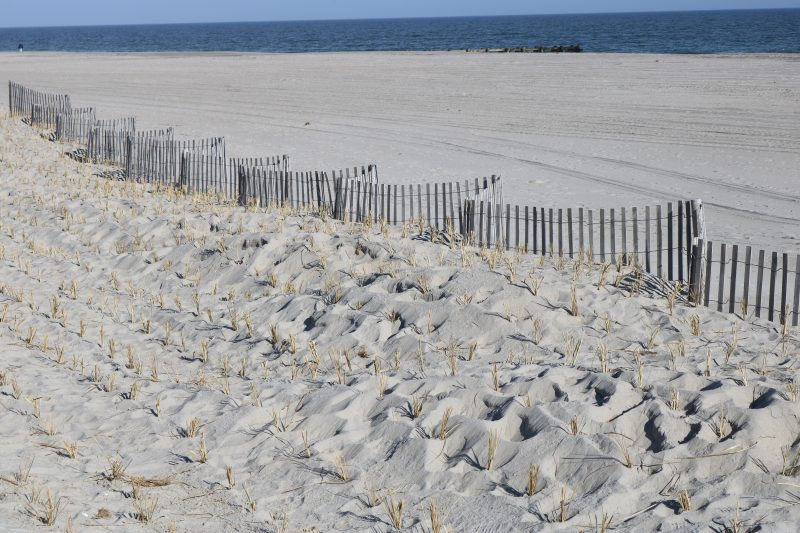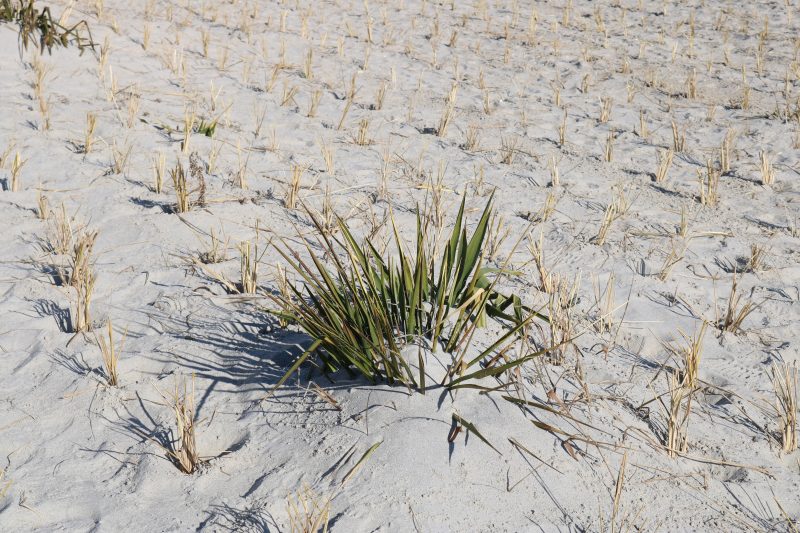 By DONALD WITTKOWSKI
By DONALD WITTKOWSKI
It looks like a farmer’s field with freshly planted crops poking out of the soil.
Brownish-green stalks of vegetation only a few inches high are neatly arranged in long rows that appear perfectly spaced apart.
But in this case, the “soil” is the white sand and the “fields” are the dunes at the 88th Street beach in Sea Isle City.
Sand dunes form a natural barrier to protect Sea Isle against coastal storms, acting as a massive wall to block the raging surf from damaging or destroying homes and businesses.
To fortify the dunes, the U.S. Army Corps of Engineers is planting dune grass and other vegetation as the last part of a beach replenishment project in 2020 that restored Sea Isle’s storm-eroded shoreline with more than 750,000 cubic yards of fresh sand.
“Every bit of beach that was replenished will likely have dune plantings as well,” city spokeswoman Katherine Custer said in an interview Friday.

A sign reminds beachgoers to stay off the environmentally sensitive dunes.
Sea Isle was part of a $32.5 million beach replenishment project, which was supervised by the U.S. Army Corps of Engineers, that also included Strathmere and Ocean City.
The new sand in Sea Isle widened the beaches between 28th and 52nd streets in the midsection of town and from 74th to 93rd streets in Townsends Inlet at the southern tip of the barrier island.
In addition to widening the beaches, the project also repaired the dunes, beach access points and sand fencing that were damaged by storms.
Most dramatically, the dunes in Townsends Inlet have been reshaped and now have a smooth, contoured appearance. Before, the dunes had been sliced away by coastal storms, leaving cliff-like walls overlooking the beaches in some areas.
The new dunes are being reinforced with dune grass and other vegetation. Young stalks of dune grass have been planted at the 88th Street beach to start. Much more dune grass is to come in the other areas that were restored by the beach replenishment project.
“It’s the finishing touch to help protect the shore,” Custer said. “The dune structure plays an important role in storm protection.”

A patch of green vegetation sprouts from the dune next to the newly planted grass.
Plants help the dunes build up through their natural cycle, allowing them to become stronger as they mature, according to the Pinelands Preservation Alliance, a private, nonprofit environmental organization.
“Mature dunes serve as the first line of defense during storm events,” the alliance said in a statement.
When Hurricane Sandy pummeled the New Jersey coast in 2012, some areas were devastated, while others were relatively unscathed or even untouched.
Parts of the shore that fared the best during the hurricane often were those protected by the older, more robust sand dunes fortified by grass or other vegetation, the alliance said.
The new dune grass being planted in Sea Isle is in its winter dormancy, but will be fertilized in the spring “to bring it to life,” Custer said.
The young dunes will link up with more mature dunes nearby that are covered with thick vegetation to form a sandy barrier protecting Sea Isle from one end of the island to the other.
Although there have been some coastal storms, Sea Isle’s shoreline has been holding up well since the beach replenishment project was completed last summer, Custer said.
“I haven’t heard of any erosion,” she said. “It sounds like our beaches are hanging tough.”

The rows of dune grass will help to strengthen the dunes once they grow out in the spring.
 By DONALD WITTKOWSKI
It looks like a farmer’s field with freshly planted crops poking out of the soil.
Brownish-green stalks of vegetation only a few inches high are neatly arranged in long rows that appear perfectly spaced apart.
But in this case, the “soil” is the white sand and the “fields” are the dunes at the 88th Street beach in Sea Isle City.
Sand dunes form a natural barrier to protect Sea Isle against coastal storms, acting as a massive wall to block the raging surf from damaging or destroying homes and businesses.
To fortify the dunes, the U.S. Army Corps of Engineers is planting dune grass and other vegetation as the last part of a beach replenishment project in 2020 that restored Sea Isle’s storm-eroded shoreline with more than 750,000 cubic yards of fresh sand.
“Every bit of beach that was replenished will likely have dune plantings as well,” city spokeswoman Katherine Custer said in an interview Friday.
By DONALD WITTKOWSKI
It looks like a farmer’s field with freshly planted crops poking out of the soil.
Brownish-green stalks of vegetation only a few inches high are neatly arranged in long rows that appear perfectly spaced apart.
But in this case, the “soil” is the white sand and the “fields” are the dunes at the 88th Street beach in Sea Isle City.
Sand dunes form a natural barrier to protect Sea Isle against coastal storms, acting as a massive wall to block the raging surf from damaging or destroying homes and businesses.
To fortify the dunes, the U.S. Army Corps of Engineers is planting dune grass and other vegetation as the last part of a beach replenishment project in 2020 that restored Sea Isle’s storm-eroded shoreline with more than 750,000 cubic yards of fresh sand.
“Every bit of beach that was replenished will likely have dune plantings as well,” city spokeswoman Katherine Custer said in an interview Friday.

 A patch of green vegetation sprouts from the dune next to the newly planted grass.
Plants help the dunes build up through their natural cycle, allowing them to become stronger as they mature, according to the Pinelands Preservation Alliance, a private, nonprofit environmental organization.
“Mature dunes serve as the first line of defense during storm events,” the alliance said in a statement.
When Hurricane Sandy pummeled the New Jersey coast in 2012, some areas were devastated, while others were relatively unscathed or even untouched.
Parts of the shore that fared the best during the hurricane often were those protected by the older, more robust sand dunes fortified by grass or other vegetation, the alliance said.
The new dune grass being planted in Sea Isle is in its winter dormancy, but will be fertilized in the spring “to bring it to life,” Custer said.
The young dunes will link up with more mature dunes nearby that are covered with thick vegetation to form a sandy barrier protecting Sea Isle from one end of the island to the other.
Although there have been some coastal storms, Sea Isle’s shoreline has been holding up well since the beach replenishment project was completed last summer, Custer said.
“I haven’t heard of any erosion,” she said. “It sounds like our beaches are hanging tough.”
A patch of green vegetation sprouts from the dune next to the newly planted grass.
Plants help the dunes build up through their natural cycle, allowing them to become stronger as they mature, according to the Pinelands Preservation Alliance, a private, nonprofit environmental organization.
“Mature dunes serve as the first line of defense during storm events,” the alliance said in a statement.
When Hurricane Sandy pummeled the New Jersey coast in 2012, some areas were devastated, while others were relatively unscathed or even untouched.
Parts of the shore that fared the best during the hurricane often were those protected by the older, more robust sand dunes fortified by grass or other vegetation, the alliance said.
The new dune grass being planted in Sea Isle is in its winter dormancy, but will be fertilized in the spring “to bring it to life,” Custer said.
The young dunes will link up with more mature dunes nearby that are covered with thick vegetation to form a sandy barrier protecting Sea Isle from one end of the island to the other.
Although there have been some coastal storms, Sea Isle’s shoreline has been holding up well since the beach replenishment project was completed last summer, Custer said.
“I haven’t heard of any erosion,” she said. “It sounds like our beaches are hanging tough.”
 The rows of dune grass will help to strengthen the dunes once they grow out in the spring.
The rows of dune grass will help to strengthen the dunes once they grow out in the spring.